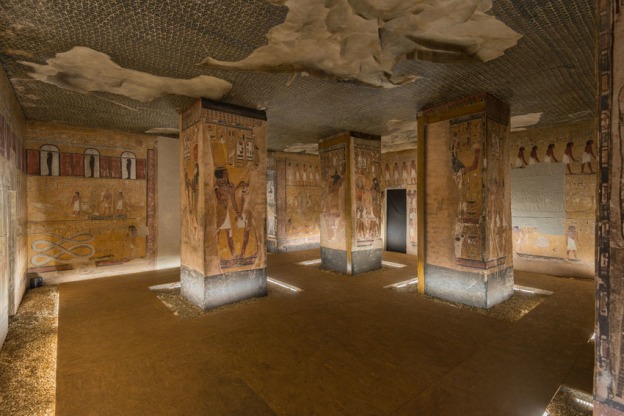Introduction
Early in the year (2018) I went to an exhibition in the Antikenmuseum, Basel: Scanning Seti: The regeneration of a Pharaonic Tomb. This exhibition impressed me immensely through its vey innovative display techniques. However, I did not consider writing up for this blog at the time – it never occurred to me that there was any connection with photography. However, in a recent discussion (here) concerning my assignment 3 for self portraiture (here) a reference was made to the fact that my images were reminiscent of Egyptian tomb paintings and it could be that I was subliminally influenced by this exhibition. So retrospectively I am recording my feelings on the exhibition and try to take learning from the visit.
Discussion
Background
Quoting the introduction to the exhibition (Factumfoundation.org, 2018)
is an immersive experience that transports the visitor to the most magnificent tomb of the Valley of the Kings in Luxor through the use of cutting-edge technology, 1:1 scale, perfect facsimiles and original objects. Conceived by Factum Foundation, Madrid, the Antikenmuseum and the University of Basel, and designed by Skene Catling de la Peña, London, this is an exciting, profoundly moving and erudite reflection on the past, our cultural history, how it can speak to us and how it is preserved.
Details and images of the exhibition can be found in (Factumfoundation.org, 2018) which i will not repeat here. I will focus on the aspects that struck me and try to interpret them through the les of photography.
My view
The following aspects that struck me during and after the visit:
- Through the use of technology the ability to recreate a totally emerse experience
- The many different ways that information was presented (film, photography, interactive computer screens, written word, facsimiles, quizzes) in order to engage the visitor.
- Through this form of exhibition there is no need to see the original.
- The strong atmosphere created by lighting and the ability to move through the tomb replica.
- I was fascinated by the story of the journey of the dead through the underworld.
- The story of how early archaeologists destroyed (unintentionally?) much of what they uncovered I found shocking.
Relationship to photography
In hindsight I can see the following relationships to contemporary photography:
- Questions of around truth, originality, copies
- Use of multiple display techniques to produce a more engaging and thoughtful impression.
- The Egyptian iconography is deep seated in our (western?) society and still viewed as something mysterious and can be used a basis for narrative.
- The use of replica is maybe a route that photography (3D?) could follow.
What I learned
Reflecting on the visit and using the context of my self portraiture work I have learned the following:
- Do not underestimate subliminal influences in producing work; sometimes requires a third party to catalyse the thoughts
- Copies can be more powerful than the original – is this simply what photography is about? What does it take to be this: accessibility, engaging, new perspectives, multi-media?
- There are universal stories that endure over the years
References
Factumfoundation.org. (2018). Factum Foundation :: Scanning Seti: The regeneration of a Pharaonic Tomb. [online] Available at: http://www.factumfoundation.org/pag/1015/Scanning-Seti-I-The-regeneration-of-a-Pharaonic-Tomb [Accessed 17 Aug. 2018].


Pingback: Update images for Self Portraits | Open College of the Arts: A log by Peter Hungerford
Pingback: Update images for Self Portraits (2) | Open College of the Arts: A log by Peter Hungerford
Pingback: Assignment 3: Research | Open College of the Arts: A log by Peter Hungerford
Pingback: Assignment 3 – Putting yourself in the picture – Submission | Open College of the Arts: A log by Peter Hungerford
Pingback: Overview of site | Open College of the Arts: A log by Peter Hungerford
Pingback: Assignment 3: Putting yourself in the picture – Final submission | Open College of the Arts: A log by Peter Hungerford